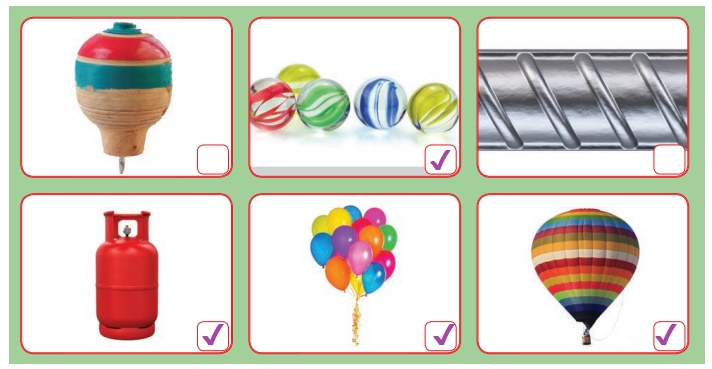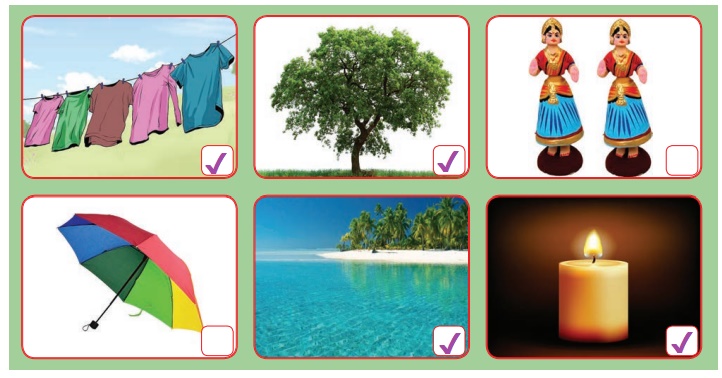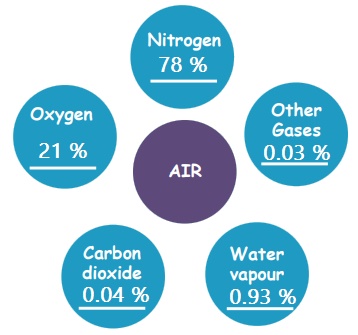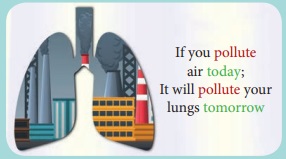Air We Breathe | Term 3 Chapter 3 | 4th Science - Questions with Answers | 4th Science : Term 3 Unit 3 : Air We Breathe
Chapter: 4th Science : Term 3 Unit 3 : Air We Breathe
Questions with Answers
Air We Breathe (Term 3 Chapter 3 | 4th Science)
EVALUATION
I. Choose the
correct answer.
1. Air is a ___________.
(a) Mixture
(b) Compound
(c) Complex
Answer: (a) Mixture
2. Percentage of Oxygen in air is about ___________%.
(a) 21
(b) 78
(c) 1
Answer: (a) 21
3. Root nodules of some plants contain ___________.
(a) Oxygen
(b) Nitrogen
(c) Neon
Answer: (b) Nitrogen
4. The major cause of air pollution is ___________.
(a) Waste
(b) Smoke
(c) Water vapour
Answer: (b) Smoke
II. Who am I?
1. I am a mixture of gases.
Air
2. I give you oxygen.
Plants
3. I am not the supporter of burning.
Carbon dioxide
4. You can help me to decrease pollution by riding on me.
Bicycle
III. Write ‘True‛
or ‘False‛.
1. Plants need nitrogen for their growth. True
2. Air is made up of oxygen only. False
3. The gas used for burning things is Argon. False
4. Carbonated drinks are bad to health. True
IV. Math the
following.
1. Nitrogen - Air pollution
2. Balloon - Smoke and fog
3. Smog - 78%
4. Lung cancer – Air
Answer:
1. Nitrogen - 78%
2. Balloon - Air
3. Smog - Smoke
and fog
4. Lung cancer – Air pollution
V. Fill in the
blanks.
1. Air is a mixture of many gases.
2. Amount of carbon dioxide in the air is 0.03
%.
3. We inhale oxygen gas.
4. Carbon dioxide is used in fire extinguishers.
VI. Answer the
following questions in brief.
1. What are the importance of air in our daily life?
• Oxygen present in air is needed for respiration.
• We can speak and hear the sound only when there
is air around.
• Air helps in the dispersal of seeds for plant
reproduction.
• Monsoon and rain occurs due to the wind action.
• Air regulates the atmospheric temperature.
2. What are the components of air?
Nitrogen - 78%
Oxygen - 21%
Carbon dioxide - 0.03%
Argon and other gases - 0.07%
3. What are the adverse effects of air pollution?
Global warming, Formation of smog, Formation of
acid rain, Aerosol formation, Depletion of Ozone
4. List uses of oxygen.
1. All living things use oxygen for breathing.
2. Oxygen is essential for burning.
3. Oxygen cylinders are used in hospitals to enable
the patients to breathe when they cannot breathe normally.
4. Oxygen is used in gas welding.
VII. Give short
answers.
1. How can we reduce air pollution?
Air pollution can be reduced by the following
steps.
1. Alternative source of energy (E.g. Solar energy)
should be used.
2. Air filters should be used to prevent harmful
gases mixing with air.
3. Smoke emission test and certification of motor
vehicles must be enforced.
4. More trees should be planted to absorb carbon dioxide.
2. What are the diseases caused due to air pollution?
Air pollution has bad impact on human health. When
the pollutants increase in air, they irritating in the eyes, nose and throat.
Air pollution can also produce wheezing, coughing and breathing problems in
humans.
1. Respiratory diseases. Eg. Flu, Tuberculosis
2. Cardiovascular damage
3. Fatigue, headaches and anxiety
4. Nervous system damage
3. List out the uses of carbon dioxide.
1. Carbon dioxide helps plants in photosynthesis.
2. It is used in fire extinguishers.
3. It is used in refrigerators as dry ice for
cooling purposes.
4. It is used to make plastics and polymers.
ACTIVITY
Take a squeezable bottle. Make a hole on the lid and close the bottle tightly. Bring the bottle near your face and press the bottle. What do you feel?

Let us do
Tick the objects which have air in them.

Let us do
Tick the object which gives out water vapour.

Activity
Write the percentage of the gases present in air.

Activity
You might have seen some huge colourful balloons flying high in malls. Those balloons are filled with nitrogen gas. Write the reason for filling nitrogen gas in balloons.
Nitrogen is an inert gas. It is similar to air but it is slightly lighter than air. So when there is no necessity to lift the balloon very high, we use nitrogen gas.
ACTIVITY
Classify the following.
( Dog, cat, coconut tree, monkey, brinjal plant, papaya plant)

Activity
Look at the path of light rays entering through window of your home/school. You can see lot of tiny particles suspended and moving in the air. These are dust particles. You can also test the same with the help of a torch light in darkness.

Activity
Tick![]() the causes of global warming
the causes of global warming

Activity
• Go by walk or use a bicycle to nearby places.
• Plant more trees.

Activity
Write slogans on harmful effects of air pollution in a chart and stick it on the display board

1. Polluted air, harms our heir.
2. Pollution kills, brings all ills
3. Smoke and fog like rabid dog.
4. Bike race thrills but pollution kills.
Related Topics